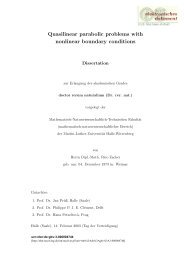Solubilisierung stark lipophiler Arzneistoffe in lipidhaltige ...
Solubilisierung stark lipophiler Arzneistoffe in lipidhaltige ...
Solubilisierung stark lipophiler Arzneistoffe in lipidhaltige ...
Erfolgreiche ePaper selbst erstellen
Machen Sie aus Ihren PDF Publikationen ein blätterbares Flipbook mit unserer einzigartigen Google optimierten e-Paper Software.
Summary<br />
In all selected surfactant systems, no substantial changes <strong>in</strong> aggregate sizes were<br />
noticed after the addition of steroids <strong>in</strong> concentrations adequately below the saturation<br />
values. A remarkable <strong>in</strong>crease <strong>in</strong> aggregate sizes was first obta<strong>in</strong>able after lipid addition.<br />
This was associated <strong>in</strong> the case of NaGDC with the formation of the well known large<br />
bile salt-lecith<strong>in</strong> mixed micelles whose structure is still to date a subject of wide argument.<br />
In the case of Br35, the aggregate growth was <strong>in</strong>terpreted by the <strong>in</strong>corporation of<br />
OS molecules <strong>in</strong>to the region of surfactant hydrocarbon moieties to form together a<br />
dist<strong>in</strong>ct fluid-like hydrophobic core <strong>in</strong> the aggregate <strong>in</strong>terior, and thereby lead<strong>in</strong>g to an<br />
enlargement of the whole aggregate. The <strong>in</strong>crease of the micellar size follow<strong>in</strong>g OS<br />
addition to the HTAB system was attributed to the formation of rod-like mixed micelles.<br />
The change <strong>in</strong> the micellar size was <strong>in</strong>dependent of the added model drugs to the lipidconta<strong>in</strong><strong>in</strong>g<br />
b<strong>in</strong>ary systems of NaGDC or Br35, whereas it showed a dependency on the<br />
molecular characteristics of added steroids (i.e. ester cha<strong>in</strong> length and lipophilicity) <strong>in</strong><br />
the case of OS conta<strong>in</strong><strong>in</strong>g HTAB mixed systems. The last observation was considered to<br />
confirm an active contribution of the added testosterone derivatives to the formation of<br />
the rod-like micellar structure, brought about most likely by <strong>in</strong>creas<strong>in</strong>g the pack<strong>in</strong>g<br />
parameter (PP) <strong>in</strong> the micellar assembly as a direct result of the amphiphilic character of<br />
these drugs.<br />
Although the growth <strong>in</strong> the micellar size <strong>in</strong> the case of the mixed micellar systems of<br />
NaGDC is coupled with an <strong>in</strong>crease <strong>in</strong> the aggregation number of the surfactant<br />
molecules, the measurements with micellar aff<strong>in</strong>ity capillary electrophoresis <strong>in</strong>dicated no<br />
significant change <strong>in</strong> the effective mobility of the micelles. This was ascribed, <strong>in</strong><br />
compliance with other works, to a decrease <strong>in</strong> the net surface charge density of the<br />
micelles, <strong>in</strong>duced by the <strong>in</strong>corporation of lecith<strong>in</strong> molecules. Despite the high amount of<br />
solubilized OS <strong>in</strong> Br35 systems, no significant change was detected <strong>in</strong> the surface<br />
electric charge of aggregates. Accord<strong>in</strong>gly, this confirmed the <strong>in</strong>clusion of almost all OS<br />
molecules <strong>in</strong>to the aggregate core, <strong>in</strong> a way that they were not able to effectively<br />
<strong>in</strong>fluence the surface electric charge. In contrast, the low amounts of solubilized OS<br />
molecules <strong>in</strong> HTAB systems <strong>in</strong>duced a considerable <strong>in</strong>crease of surface positive electric<br />
charge of micelles due to the formation of large rod-like structures with a high<br />
aggregation number of surfactant molecules.<br />
Furthermore, measurements of the cybotactic polarity <strong>in</strong> the vic<strong>in</strong>ity of the conjugated<br />
cyclic ketone functions of the solubilized steroids <strong>in</strong>dicated an <strong>in</strong>crease <strong>in</strong> the polarity of<br />
the surround<strong>in</strong>g environment after lipid addition to NaGDC and Br35 systems (except for<br />
solubiliz<strong>in</strong>g TU <strong>in</strong> Br35 systems), whereas this addition <strong>in</strong> the case of HTAB systems led<br />
to a decrease <strong>in</strong> the cybotactic polarity around the mentioned ketone functions. The first<br />
observation was attributed to an <strong>in</strong>creased hydratation grade at the superficial layers of<br />
aggregates, whereas the second observation perta<strong>in</strong>ed most likely to a shift of steroids<br />
embedd<strong>in</strong>g sites to deeper positions <strong>in</strong> the micellar structure due to a reduced adhesion<br />
between the hydrocarbon cha<strong>in</strong>s <strong>in</strong> the micellar <strong>in</strong>terior follow<strong>in</strong>g the lipid addition.<br />
The obta<strong>in</strong>ed results suggested also that testosterone differs entirely from its esters <strong>in</strong><br />
their arrangement ways with<strong>in</strong> the aggregates. Whereas its polarity and relatively small<br />
molecular size cause testosterone to be embedded <strong>in</strong> the more hydrophilic solubiliz<strong>in</strong>g<br />
sites adjacent to the layer of polar surfactant head groups <strong>in</strong> the aggregates, its esters<br />
<strong>in</strong>corporate themselves deeper <strong>in</strong> more hydrophobic sites with<strong>in</strong> the aggregate <strong>in</strong>terior<br />
due to their <strong>in</strong>creased lipophilicity and molecular sizes. It was additionally concluded,<br />
that the testosterone molecule arranges itself with<strong>in</strong> the aggregates <strong>in</strong> an entirely<br />
opposite way as compared with its esters by direct<strong>in</strong>g its ketone group toward the<br />
aggregate <strong>in</strong>terior while its hydroxyl group rema<strong>in</strong>s anchored with<strong>in</strong> the superficial polar<br />
104










